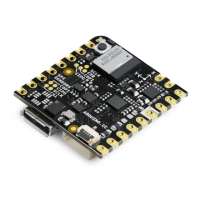
Do you have a question about the Arduino Nicla Voice and is the answer not in the manual?
| Operating Voltage | 3.3 V |
|---|---|
| Digital I/O Pins | 14 |
| Analog Input Pins | 6 |
| Dimensions | 22.86 mm x 22.86 mm |
| Input Voltage | 3.3V - 5V |
| Bluetooth | Bluetooth Low Energy (BLE) |
| Microphone | Digital MEMS microphone |
| IMU | 6-axis |
| Interfaces | I2C, SPI, UART |
Key application domains for the Arduino Nicla Voice, including speech recognition and sensor networks.
Details on the ANNA-B112 module, its microcontroller, memory, and connectivity.
Information on the Syntiant NDP120 for AI algorithms and low-power inference.
Specifications for the 6-axis IMU including accelerometer and gyroscope.
Details on the 3-axis magnetometer for sensing magnetic field variations.
Information on the MEMS microphone, its frequency range, and dynamic range.
Overview of castellated pads (J1, J2, J3) and other I/O interfaces on the board.
Details on power input/output and the external PDM microphone connector.
Use cases and deployment scenarios for the Arduino Nicla Voice board.
Information on included accessories and compatible Arduino products.
Guidance on the physical assembly and setup of the Arduino Nicla Voice.
Visual representation of the Arduino Nicla Voice's internal components and connections.
Diagrams illustrating the placement of connectors on the top and bottom of the board.
Detailed measurements and dimensions of the Arduino Nicla Voice board's front.
Technical specifications of the nRF52832 microcontroller in the ANNA-B112 module.
Information on the Syntiant NDP120 for AI processing and neural networks.
Description of the 9-axis IMU capabilities using BMI270 and BMM150 ICs.
Details on the I2C LED driver and its capabilities for the RGB LED.
Information on the internal MEMS microphone and PDM signal transmission.
Role of the SAMD11 microcontroller as a USB bridge and JTAG controller.
Diagram and explanation of the power flow and voltage regulation on the board.
Instructions for setting up and using the Arduino Desktop IDE for programming.
Steps to use the Arduino Web Editor for programming the Nicla Voice.
How to integrate the Nicla Voice with Arduino Cloud for IoT applications.
Accessing example code and finding additional resources for the Nicla Voice.
Steps to recover the board via bootloader mode if the sketch locks up.
Detailed pin functions for the J1 Nicla Header A connector.
Detailed pin functions for the J2 Nicla Header B connector.
Description of the J2 fins as test points for debugging capabilities.
Diagram and dimensions detailing the overall size of the Arduino Nicla Voice board.
Statement of conformity with EU directives for free movement within the European Union.
Information on compliance with RoHS 2, RoHS 3, and REACH regulations for hazardous substances.
Arduino's declaration regarding the sourcing of conflict minerals in its products.
Conditions for FCC compliance, including restrictions on interference and operation.
Guidelines for safe installation and operation concerning RF radiation exposure.
Industry Canada SAR warning regarding minimum distance for operation.
Details about Arduino SRL, including its name and headquarters address.
Links to essential online resources for the Arduino Nicla Voice, including IDE and project hub.
Information regarding the first release of the document, including date and revision number.
Warnings and precautions for qualified professionals regarding product installation and use.
Recommendations for firmware updates, password security, and system anti-virus.
Discussion on potential security risks, hacking, and compromises for IoT products.
Information on data encryption, communications, and dependence on third-party services.
Guidance on battery life management and periodic testing for battery-operated devices.
Warning about small parts posing a choking hazard to children and pets.
Statement disclaiming all express, implied, or statutory warranties for products and software.
Disclaimers regarding product security, performance, and liabilities from third-party actions.
Requirement for qualified technicians to check systems at least every two years.
User responsibility for privacy laws, consent, and data handling for biometric features.
Notice that document information may change without prior notification.
